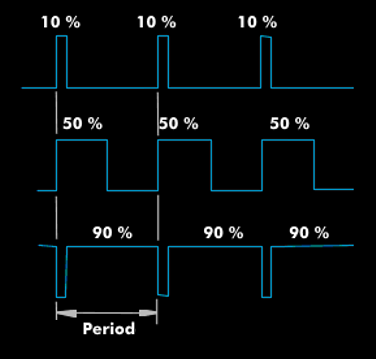duty cycle
The duty cycle is a characteristic value of pulses, which is defined by the temporal ratio of pulse duration to pulse period. It can be the on-time to the period duration.
The time ratio between a square wave signal and the pulse duration or pulse width is the duty cycle or pulse duty factor. While the duty cycle (`delta`) is a dimensionless number, the duty cycle is expressed as a percentage. Thus, for a pulse signal or a square wave signal with a pulse duration assumed to be 10 ms with a period of 100 ms, the duty cycle is 0.1. The duty cycle for the same example is 10%.
Both characteristic values, the duty cycle and the pulse duty factor, apply equally to unmodulated square-wave signals and pulse signals, to switch-on times and switch-off times, to modulation methods or to the transmission of signals. For example, if a frequency is swept for 200 nanoseconds within a period of 1 microsecond, the duty cycle is 20%. In various modulation schemes, the duty cycle changes by modulating the pulse width. One such modulation technique is pulse width modulation( PWM).
For testing circuits, pulse gener ators and function generators can generate pulse signals with variable pulse widths, i.e. with variable duty cycles. The power of pulses depends on the pulse duration and thus on the duty cycle. It is calculated from the pulse frequency, the duty cycle and the pulse amplitude. If the duty cycle changes due to interference, this is referred to as deterministic jitter. Such a jitter is composed of various jitter components. For example, periodic jitter, data-dependent jitter and distortions of the duty cycle.

